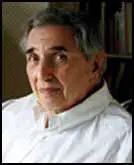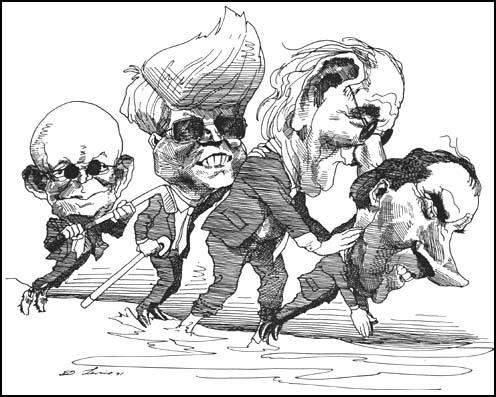David Levine

David Levine, the son of a small businessman, was born in New York City on 20th December, 1926. His mother was a nurse and an active member of the American Communist Party. As a child he sold copies of The Daily Worker.
Levine studied at the Brooklyn Museum Art School and the Tyler School of Art and was influenced by artists such as John Sloan and George Luks. Like these artists, as well as painting, Levine was interested in cartooning. He tried to make it as a fine artist. He later recalled that "his small paintings of garment workers and Coney Island bathers were his proudest achievements". In 1958, along with Aaron Shikler, he founded the Painters Group in Brooklyn. However, these paintings failed to sell and he had to concentrate on cartooning.
Working in the tradition of Thomas Nast and John Tenniel, Levine's drawings began being featured in Esquire in the early 1960s. His first cartoon for The New York Review of Books appeared in 1963. It has been claimed that over the next forty years 3,800 pen-and-ink caricatures of famous writers, artists and politicians appeared in the journal.
Robert Hughes, the art critic, was one of his victims. The cartoon was based on a photograph but as Hughes pointed out: “I don’t think the photograph was anything like as truthful as the drawing. Most caricature is no more than cartooning. But with Levine you always knew there was some truth emanating from the drawings. You always had the sense he was telling a truth, even when it was most unwelcome.”
Levine's work also appeared in The New York Times, The Washington Post, Rolling Stone Magazine, Sports Illustrated, New York Magazine, Time Magazine, Newsweek, The New Yorker, The Nation and Playboy. The cartoonist, Jules Feiffer, has called him "the greatest caricaturist of the last half of the 20th Century".
Levine was accused of being a member of the American Communist Party and he has been criticised for being biased against those on the right of the political spectrum. Levine admits that he was prejudiced against those in power. He has argued that "by making the powerful funny-looking... he might encourage some humility or self-awareness".

Lyndon Baines Johnson and Richard Nixon (1971)
Levine victims included Henry Kissinger, Jimmy Carter and Richard Nixon. According to Michael Carlson: "His ability to delineate subtleties of character made Levine America's finest political caricaturist since the 19th-century heyday of Thomas Nast. He drew Henry Kissinger, under an American flag blanket, copulating with the world, a female figure with the globe as her head. Another image of Kissinger, covered with tattoos representing wars, coups and assassinations, surfaced only recently in a collection of drawings that had been rejected by the New York Times editorial page. Levine was a master of visual metaphor, but apt as it was to portray Jimmy Carter as Nero, it was the oblivious bliss on Carter's face that made the caricature work. Expressions were the focus of his outsized faces, placed on withered bodies, often with the noses greatly exaggerated, creating a path for the viewer to his subject's eyes. He drew Richard Nixon more than 60 times, as everything from Don Corleone to a foetus; the ski-jump nose and five o'clock shadow framed a set of always-desperate eyes."
Michael Kimmelman has argued: "His political illustrations in The Review were a biweekly fix for the fuming left back in the 1960s and ’70s. But plenty of angry cartoonists soothed the savage public, then slipped down the memory chute. What has made Mr. Levine endure - why, hands down, he’s the greatest modern-day caricaturist and one of the great artists of the last half-century - is his embrace of ambiguity. The power of his famous image of Lyndon B. Johnson with a map of Vietnam scarred onto his stomach, a classic of American satire, derives from the fact that while he clearly reviled the president, he also allowed him his complexity. That’s also why his art became the indelible face of a journal so fiercely devoted to the power of words."
In 2006, Levine was diagnosed with macular degeneration, an eye disease that leads to blindness. No new work appeared after April 2007.
David Levine died at the New York Presbyterian Hospital on 29th December, 2009.
Primary Sources
(1) Michael Kimmelman, The New York Times (30th December, 2009)
His political illustrations in The Review were a biweekly fix for the fuming left back in the 1960s and ’70s. But plenty of angry cartoonists soothed the savage public, then slipped down the memory chute. What has made Mr. Levine endure - why, hands down, he’s the greatest modern-day caricaturist and one of the great artists of the last half-century - is his embrace of ambiguity. The power of his famous image of Lyndon B. Johnson with a map of Vietnam scarred onto his stomach, a classic of American satire, derives from the fact that while he clearly reviled the president, he also allowed him his complexity. That’s also why his art became the indelible face of a journal so fiercely devoted to the power of words...
It helped that Mr. Levine spent a lifetime drawing live models. And it also mattered that he read closely the articles he was illustrating. Brooklyn born, a red-diaper baby who believed it was Stalin, Trotsky and the other Soviet leaders who spoiled what he still called, even toward the end of his life, “a beautiful idea,” he was in person down to earth, unpretentious, a working stiff with a hangdog air - as Françoise Mouly, The New Yorker’s art editor recalled, “a loyal and kind soul.” He seemed to want people to think that the book reviews he illustrated were, intellectually speaking, over his head. But his brilliance lay in weaving their ideas with his own.
Hence the remarkable drawing he did in 1969 of Ludwig Wittgenstein, slyly kicking away an academic cap. It’s a masterpiece of psychology. The balletic gesture, typical of Mr. Levine - who conveyed in the slight slope of a shoulder or the gentle swing of a hip or some other little bodily detail a large fact about his subject’s character - in this case suggests the arrogant philosopher blithely distancing himself from philosophy.
(2) Michael Carlson, The Guardian (31st December, 2009)
This ability to delineate subtleties of character made Levine America's finest political caricaturist since the 19th-century heyday of Thomas Nast. He drew Henry Kissinger, under an American flag blanket, copulating with the world, a female figure with the globe as her head. Another image of Kissinger, covered with tattoos representing wars, coups and assassinations, surfaced only recently in a collection of drawings that had been rejected by the New York Times editorial page.
Levine was a master of visual metaphor, but apt as it was to portray Jimmy Carter as Nero, it was the oblivious bliss on Carter's face that made the caricature work. Expressions were the focus of his outsized faces, placed on withered bodies, often with the noses greatly exaggerated, creating a path for the viewer to his subject's eyes. He drew Richard Nixon more than 60 times, as everything from Don Corleone to a foetus; the ski-jump nose and five o'clock shadow framed a set of always-desperate eyes....
Beyond politics, he covered the full gamut of literary figures and other celebrities – Allen Ginsberg with frazzled hair and beard forming a map of the US, Bertrand Russell as a hippy giving the peace sign, CP Snow as Humpty Dumpty with huge, horn-rimmed spectacles. The magazine would send a copy of the article he had been commissioned to illustrate, and photographs of the subject, to him at the Brooklyn Casino, where he played tennis. His finished work was then collected from there.
